Pecharsky V.K., Zavalij P.Y. Fundamentals of Powder Diffraction and Structural Characterization of Materials
Подождите немного. Документ загружается.

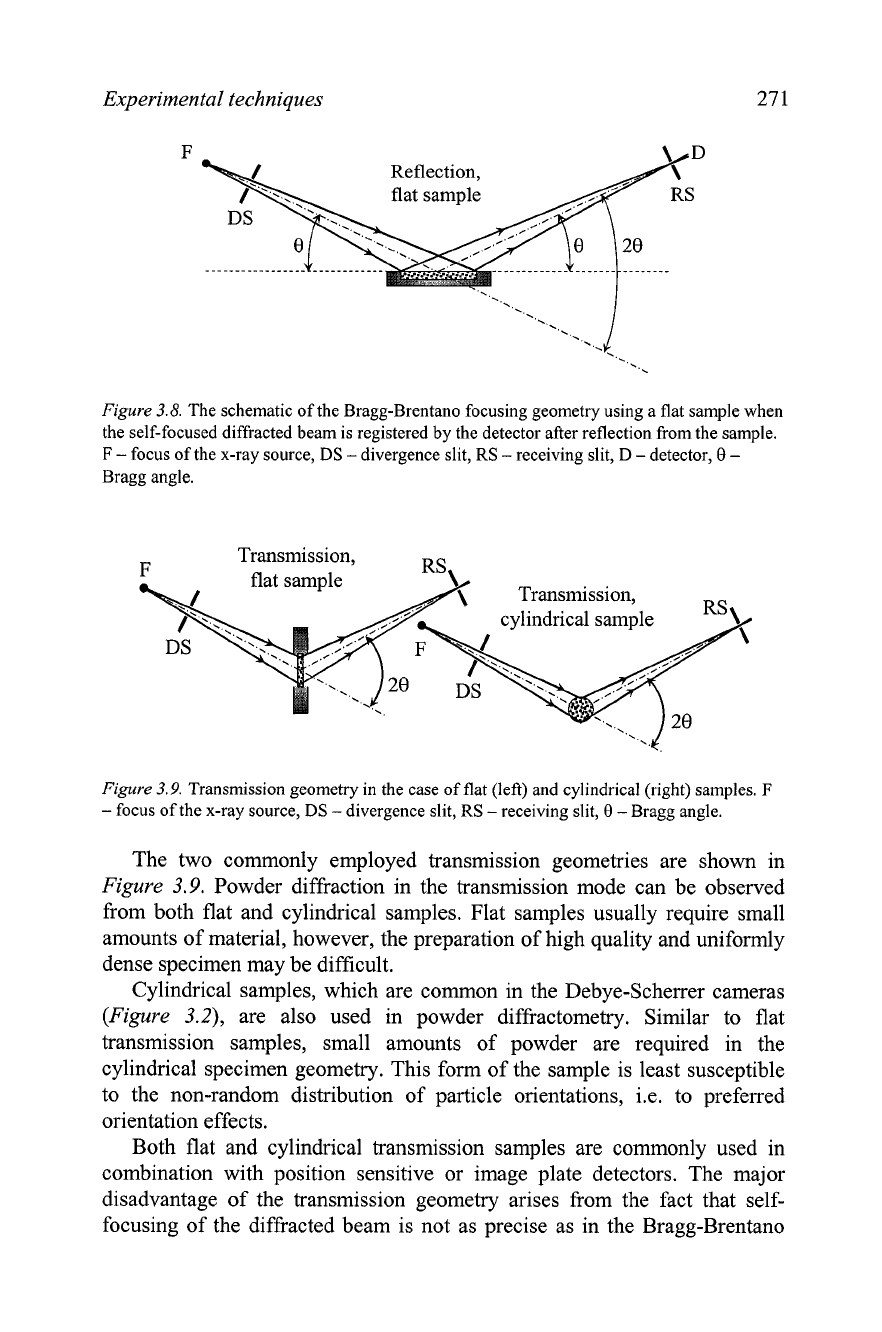
Experimental techniques
27
1
Figure
3.8.
The schematic of the Bragg-Brentano focusing geometry using a flat sample when
the self-focused diffracted beam is registered by the detector after reflection from the sample.
F
-
focus of the x-ray source, DS
-
divergence slit, RS
-
receiving slit,
D
-detector,
0
-
Bragg angle.
Figure
3.9.
Transmission geometry in the case of flat (left) and cylindrical (right) samples.
F
-
focus of the x-ray source, DS
-
divergence slit, RS
-
receiving slit,
0
-
Bragg angle.
The two commonly employed transmission geometries are shown in
Figure
3.9. Powder diffraction in the transmission mode can be observed
from both flat and cylindrical samples. Flat samples usually require small
amounts of material, however, the preparation of high quality and uniformly
dense specimen may be difficult.
Cylindrical samples, which are common in the Debye-Scherrer cameras
(Figure
3.2), are also used in powder diffractometry. Similar to flat
transmission samples, small amounts of powder are required in the
cylindrical specimen geometry. This form of the sample is least susceptible
to the non-random distribution of particle orientations,
i.e. to preferred
orientation effects.
Both flat and cylindrical transmission samples are commonly used in
combination with position sensitive or image plate detectors. The major
disadvantage of the transmission geometry arises from the fact that
self-
focusing of the diffracted beam is not as precise as in the Bragg-Brentano
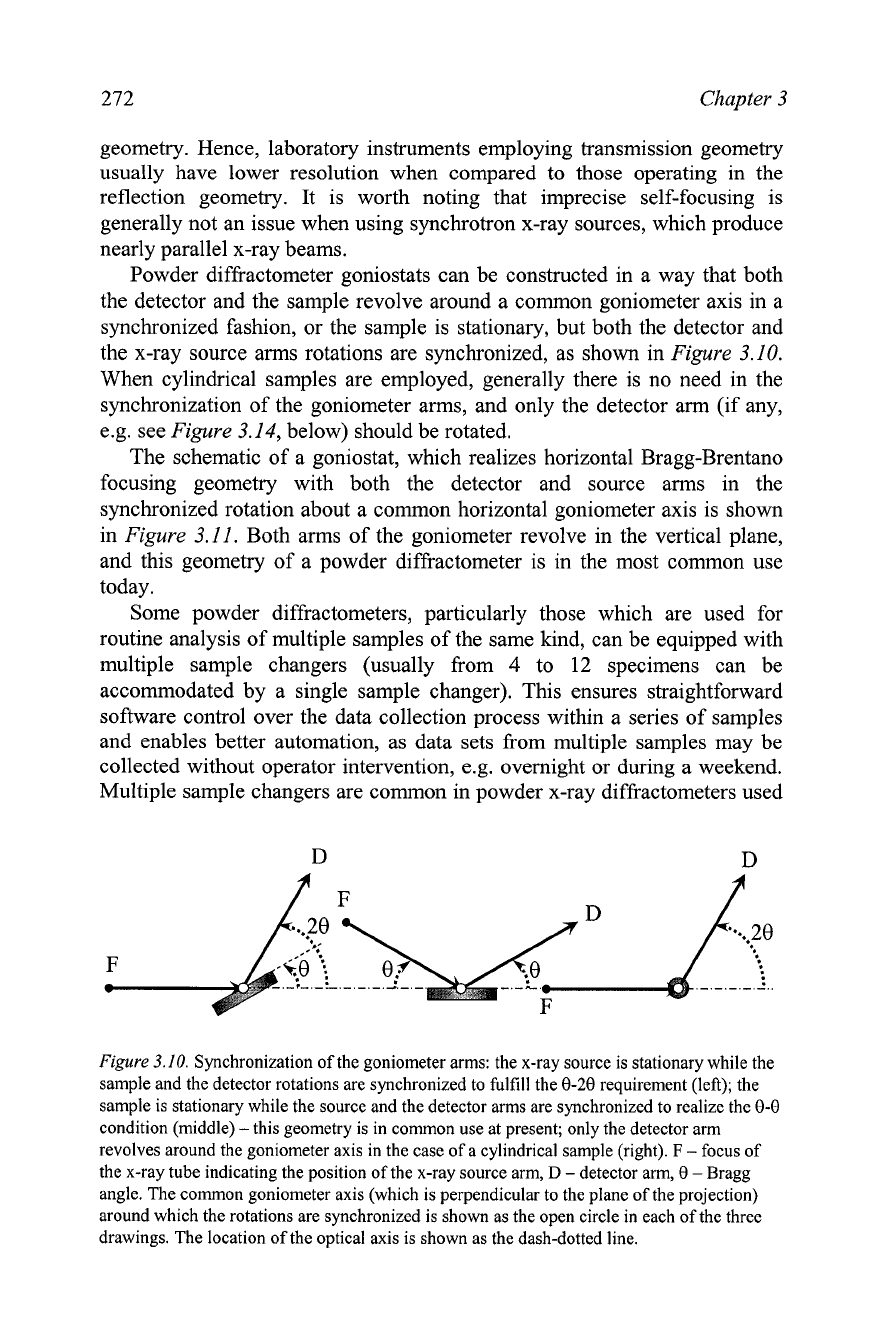
272
Chapter
3
geometry. Hence, laboratory instruments employing transmission geometry
usually have lower resolution when compared to those operating in the
reflection geometry. It is worth noting that imprecise self-focusing is
generally not an issue when using synchrotron x-ray sources, which produce
nearly parallel x-ray beams.
Powder diffractometer goniostats can be constructed in a way that both
the detector and the sample revolve around a common goniometer axis in a
synchronized fashion, or the sample is stationary, but both the detector and
the x-ray source arms rotations are synchronized, as shown in
Figure
3.10.
When cylindrical samples are employed, generally there is no need in the
synchronization of the goniometer arms, and only the detector arm (if any,
e.g. see
Figure
3.14, below) should be rotated.
The schematic of a goniostat, which realizes horizontal Bragg-Brentano
focusing geometry with both the detector and source arms in the
synchronized rotation about a common horizontal goniometer axis is shown
in
Figure
3.11. Both arms of the goniometer revolve in the vertical plane,
and this geometry of a powder diffractometer is in the most common use
today.
Some powder diffractometers, particularly those which are used for
routine analysis of multiple samples of the same kind, can be equipped with
multiple sample changers (usually from
4
to 12 specimens can be
accommodated by a single sample changer). This ensures straightforward
software control over the data collection process within a series of samples
and enables better automation, as data sets from multiple samples may be
collected without operator intervention,
e.g. overnight or during
a
weekend.
Multiple sample changers are common in powder x-ray diffractometers used
Figure
3.10.
Synchronization of the goniometer arms: the x-ray source is stationary while the
sample and the detector rotations are synchronized to fulfill the
8-28
requirement (left); the
sample is stationary while the source and the detector arms are synchronized to realize the
8-8
condition (middle)
-
this geometry is in common use at present; only the detector arm
revolves around the goniometer axis in the case of a cylindrical sample (right).
F
-
focus of
the x-ray tube indicating the position of the x-ray source arm,
D
-
detector arm,
8
-
Bragg
angle. The common goniometer axis (which is perpendicular to the plane of the projection)
around which the rotations are synchronized is shown as the open circle in each of the three
drawings. The location of the optical axis is shown as the dash-dotted line.
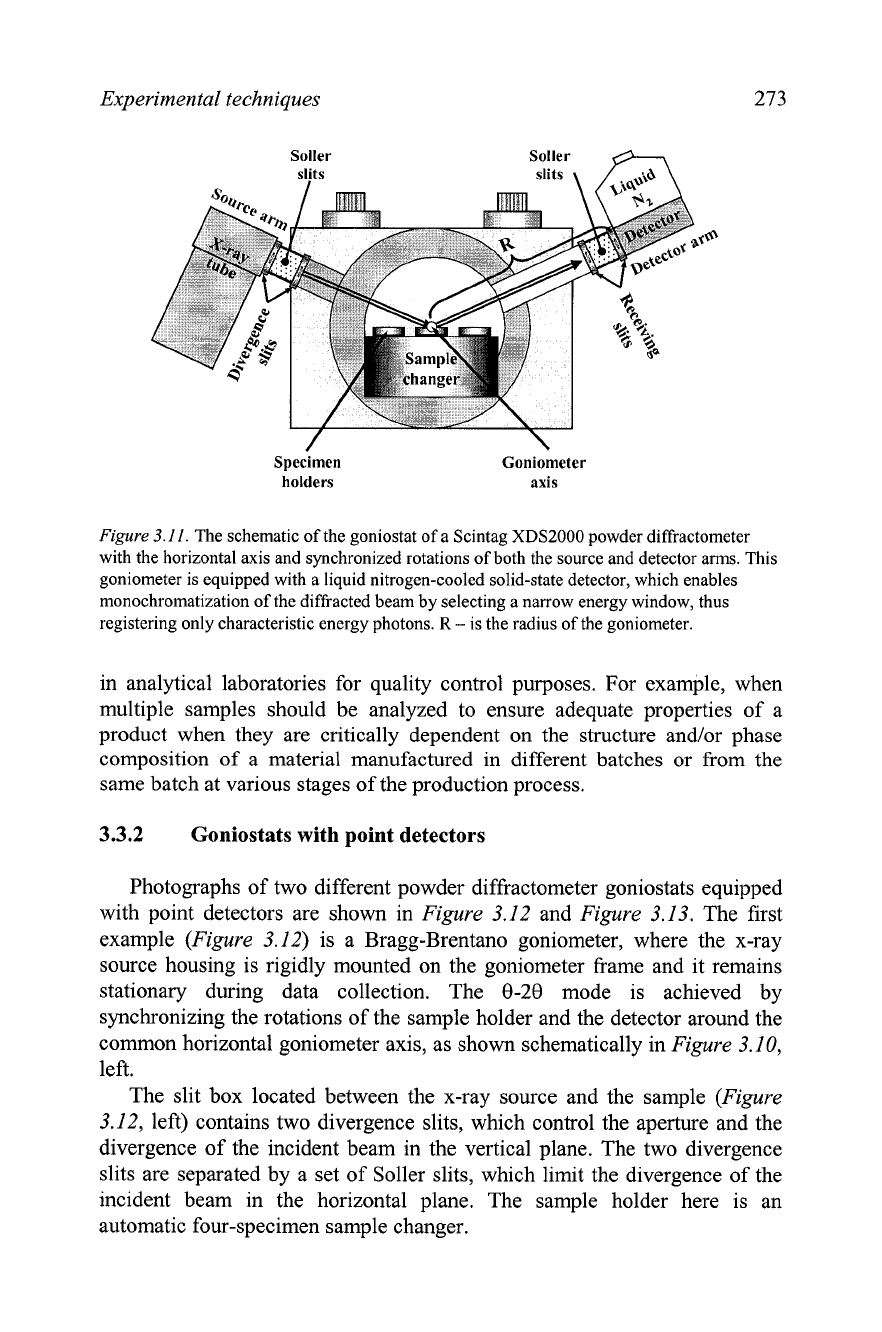
Experimental techniques
273
Specimen
holders
Goniometer
axis
Figure
3.11.
The schematic of the goniostat of a Scintag
XDS2000
powder diffractometer
with the horizontal axis and synchronized rotations of both the source and detector arms. This
goniometer is equipped with a liquid nitrogen-cooled solid-state detector, which enables
monochromatization of the diffracted beam by selecting a narrow energy window, thus
registering only characteristic energy photons.
R
-
is the radius of the goniometer.
in analytical laboratories for quality control purposes. For example, when
multiple samples should be analyzed to ensure adequate properties of a
product when they are critically dependent on the structure
andlor phase
composition of a material manufactured in different batches or from the
same batch at various stages of the production process.
3.3.2 Goniostats with point detectors
Photographs of two different powder diffractometer goniostats equipped
with point detectors are shown in
Figure
3.12 and
Figure
3.13. The first
example
(Figure
3.12) is a Bragg-Brentano goniometer, where the x-ray
source housing is rigidly mounted on the goniometer frame and it remains
stationary during data collection. The 8-28 mode is achieved by
synchronizing the rotations of the sample holder and the detector around the
common horizontal goniometer axis, as shown schematically in
Figure
3.10,
left.
The slit box located between the x-ray source and the sample
(Figure
3.12, left) contains two divergence slits, which control the aperture and the
divergence of the incident beam in the vertical plane. The two divergence
slits are separated by a set of Soller slits, which limit the divergence of the
incident beam in the horizontal plane. The sample holder here is an
automatic four-specimen sample changer.
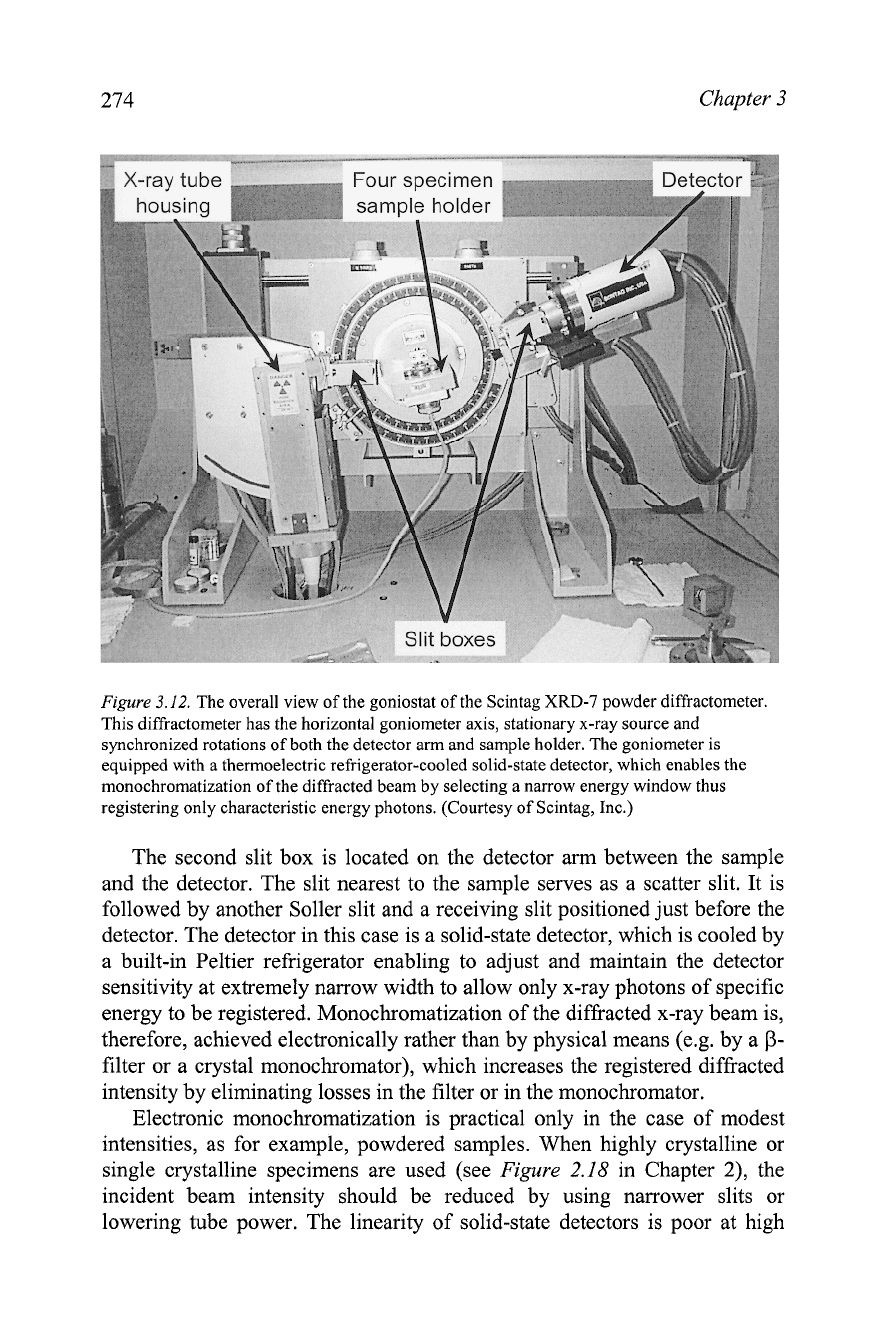
274
Chapter
3
7--
X-ray
tube Four specimen Detector
1
Figure
3.12.
The overall view of the goniostat of the Scintag
XRD-7
powder diffractometer.
This diffractometer has the horizontal goniometer axis, stationary x-ray source and
synchronized rotations of both the detector arm and sample holder. The goniometer is
equipped with a thermoelectric refrigerator-cooled solid-state detector, which enables the
monochromatization of the diffracted beam by selecting a narrow energy window thus
registering only characteristic energy photons. (Courtesy of Scintag, Inc.)
The second slit box is located on the detector arm between the sample
and the detector. The slit nearest to the sample serves as a scatter slit. It is
followed by another Soller slit and a receiving slit positioned just before the
detector. The detector in this case is a solid-state detector, which is cooled by
a built-in Peltier refrigerator enabling to adjust and maintain the detector
sensitivity at extremely narrow width to allow only x-ray photons of specific
energy to be registered. Monochromatization of the diffracted x-ray beam is,
therefore, achieved electronically rather than by physical means (e.g. by a
P-
filter or a crystal monochromator), which increases the registered diffracted
intensity by eliminating losses in the filter or in the monochromator.
Electronic monochromatization is practical only in the case of modest
intensities, as for example, powdered samples. When highly crystalline or
single crystalline specimens are used (see
Figure
2.18
in Chapter 2), the
incident beam intensity should be reduced by using narrower slits or
lowering tube power. The linearity of solid-state detectors is poor at high
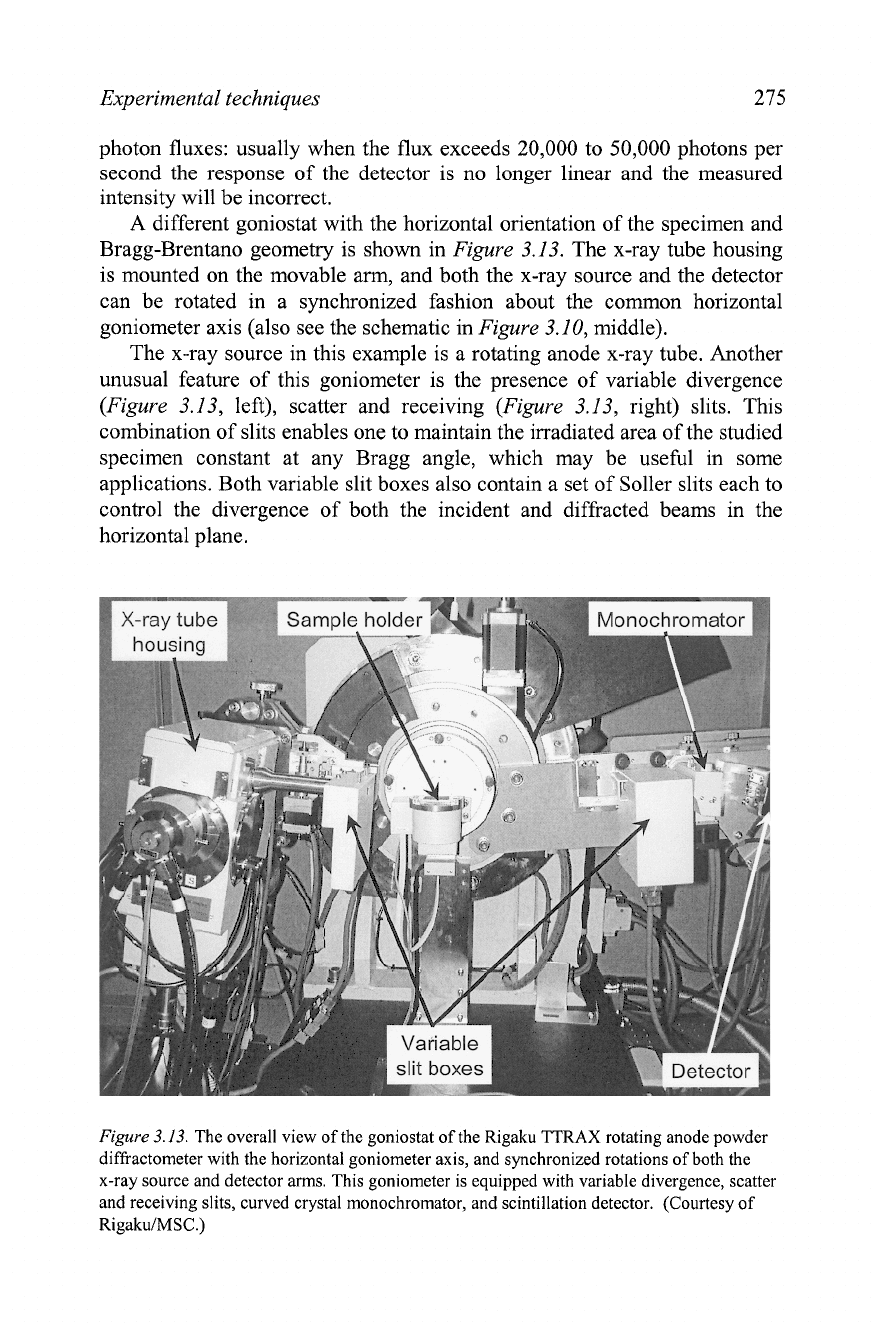
Experimental techniques 275
photon fluxes: usually when the flux exceeds 20,000 to 50,000 photons per
second the response of the detector is no longer linear and the measured
intensity will be incorrect.
A
different goniostat with the horizontal orientation of the specimen and
Bragg-Brentano geometry is shown in Figure 3.13. The x-ray tube housing
is mounted on the movable arm, and both the x-ray source and the detector
can be rotated in a synchronized fashion about the common horizontal
goniometer axis (also see the schematic in Figure 3.10, middle).
The x-ray source in this example is a rotating anode x-ray tube. Another
unusual feature of this goniometer is the presence of variable divergence
(Figure 3.13, left), scatter and receiving (Figure 3.13, right) slits. This
combination of slits enables one to maintain the irradiated area of the studied
specimen constant at any Bragg angle, which may be useful in some
applications. Both variable slit boxes also contain a set of Soller slits each to
control the divergence of both the incident and diffracted beams in the
horizontal plane.
Figure
3.13.
The overall view of the goniostat of the Rigaku TTRAX rotating anode powder
diffractometer with the horizontal goniometer axis, and synchronized rotations of both the
x-ray source and detector arms. This goniometer is equipped with variable divergence, scatter
and receiving slits, curved crystal monochromator, and scintillation detector. (Courtesy of
RigakuIMSC.)
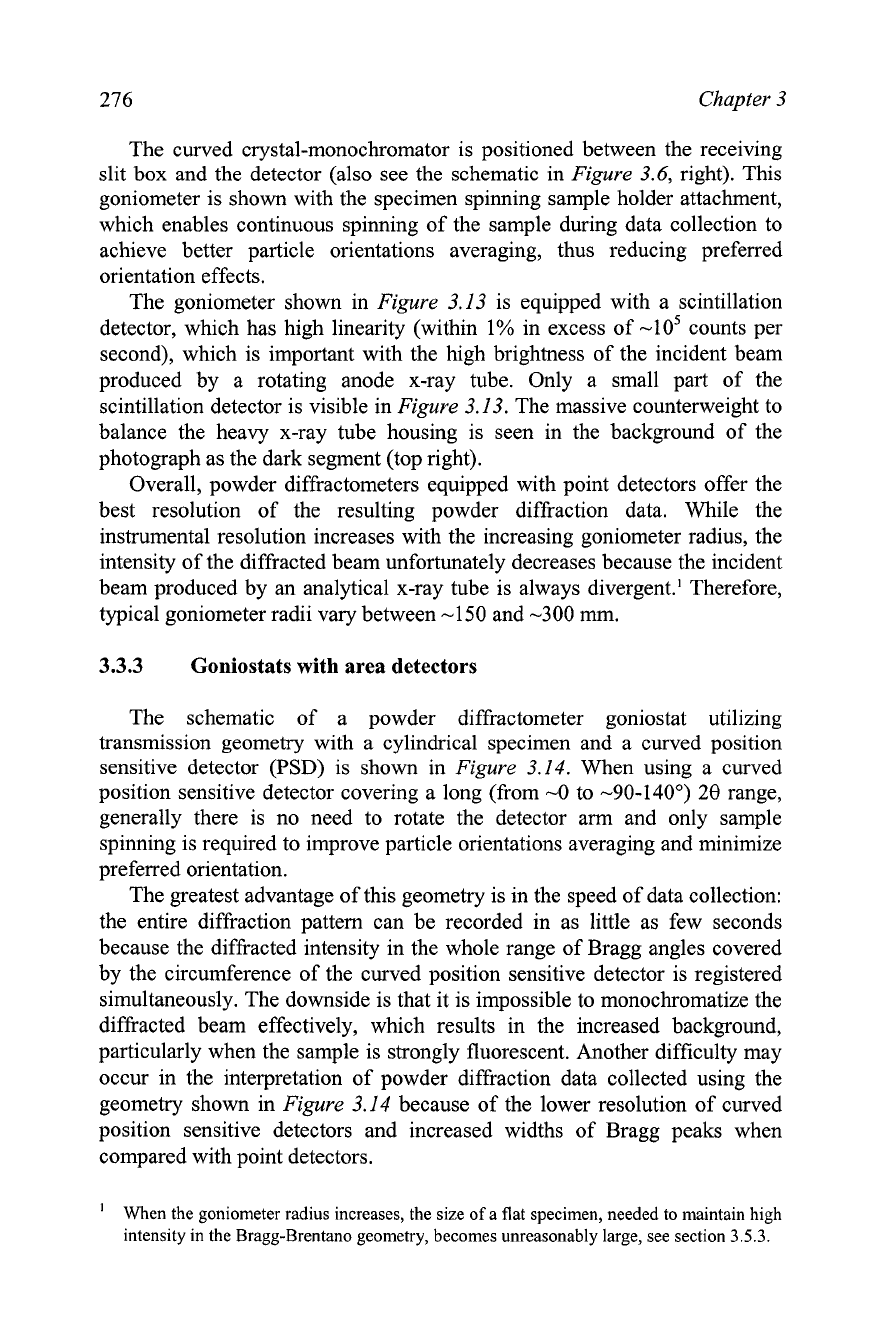
276
Chapter
3
The curved crystal-monochromator is positioned between the receiving
slit box and the detector (also see the schematic in
Figure
3.6,
right). This
goniometer is shown with the specimen spinning sample holder attachment,
which enables continuous spinning of the sample during data collection to
achieve better particle orientations averaging, thus reducing preferred
orientation effects.
The goniometer shown in
Figure
3.13
is equipped with a scintillation
detector, which has high linearity (within 1% in excess of -10' counts per
second), which is important with the high brightness of the incident beam
produced by a rotating anode
x-ray tube. Only a small part of the
scintillation detector is visible in
Figure
3.13.
The massive counterweight to
balance the heavy x-ray tube housing is seen in the background of the
photograph as the dark segment (top right).
Overall, powder diffractometers equipped with point detectors offer the
best resolution of the resulting powder diffraction data. While the
instrumental resolution increases with the increasing goniometer radius, the
intensity of the diffracted beam unfortunately decreases because the incident
beam produced by an analytical x-ray tube is always divergent.' Therefore,
typical goniometer radii vary between -150 and -300 mm.
3.3.3
Goniostats with area detectors
The schematic of a powder diffractometer goniostat utilizing
transmission geometry with a cylindrical specimen and a curved position
sensitive detector
(PSD)
is shown in
Figure
3.14.
When using a curved
position sensitive detector covering a long (from -0 to -90-140')
28
range,
generally there is no need to rotate the detector arm and only sample
spinning is required to improve particle orientations averaging and minimize
preferred orientation.
The greatest advantage of this geometry is in the speed of data collection:
the entire diffraction pattern can be recorded in as little as few seconds
because the diffracted intensity in the whole range of Bragg angles covered
by the circumference of the curved position sensitive detector is registered
simultaneously. The downside is that it is impossible to monochromatize the
diffracted beam effectively, which results in the increased background,
particularly when the sample is strongly fluorescent. Another difficulty may
occur in the interpretation of powder diffraction data collected using the
geometry shown in
Figure
3.14
because of the lower resolution of curved
position sensitive detectors and increased widths of Bragg peaks when
compared with point detectors.
'
When the goniometer radius increases, the size of a flat specimen, needed to maintain high
intensity in the Bragg-Brentano geometry, becomes unreasonably large, see section
3.5.3.
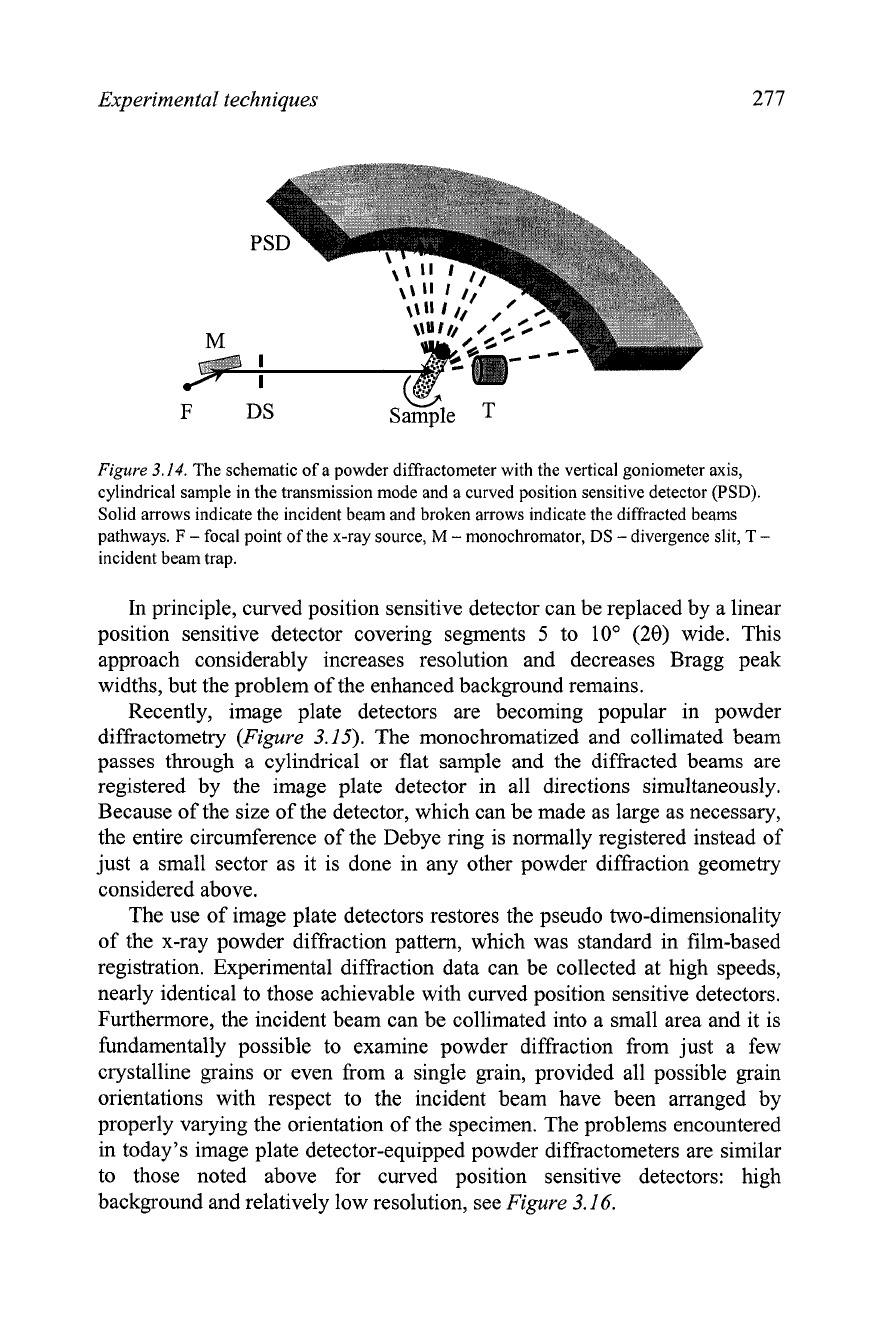
Experimental techniques
Figure
3.14.
The schematic of a powder diffractometer with the vertical goniometer axis,
cylindrical sample in the transmission mode and a curved position sensitive detector (PSD).
Solid arrows indicate the incident beam and broken arrows indicate the diffracted beams
pathways.
F
-
focal point of the x-ray source,
M
-
monochromator, DS
-
divergence slit,
T
-
incident beam trap.
In
principle, curved position sensitive detector can be replaced by a linear
position sensitive detector covering segments
5
to 10'
(28)
wide. This
approach considerably increases resolution and decreases Bragg peak
widths, but the problem of the enhanced background remains.
Recently, image plate detectors are becoming popular in powder
diffractometry
(Figure
3.15).
The monochromatized and collimated beam
passes through a cylindrical or flat sample and the diffracted beams are
registered by the image plate detector in all directions simultaneously.
Because of the size of the detector, which can be made as large as necessary,
the entire circumference of the Debye ring is normally registered instead of
just a small sector as it is done in any other powder diffraction geometry
considered above.
The use of image plate detectors restores the pseudo two-dimensionality
of the x-ray powder diffraction pattern, which was standard in film-based
registration. Experimental diffraction data can be collected at high speeds,
nearly identical to those achievable with curved position sensitive detectors.
Furthermore, the incident beam can be collimated into a small area and it is
fundamentally possible to examine powder diffraction from just a few
crystalline grains or even from a single grain, provided all possible grain
orientations with respect to the incident beam have been arranged by
properly varying the orientation of the specimen. The problems encountered
in today's image plate detector-equipped powder diffractometers are similar
to those noted above for curved position sensitive detectors: high
background and relatively low resolution, see
Figure
3.16.
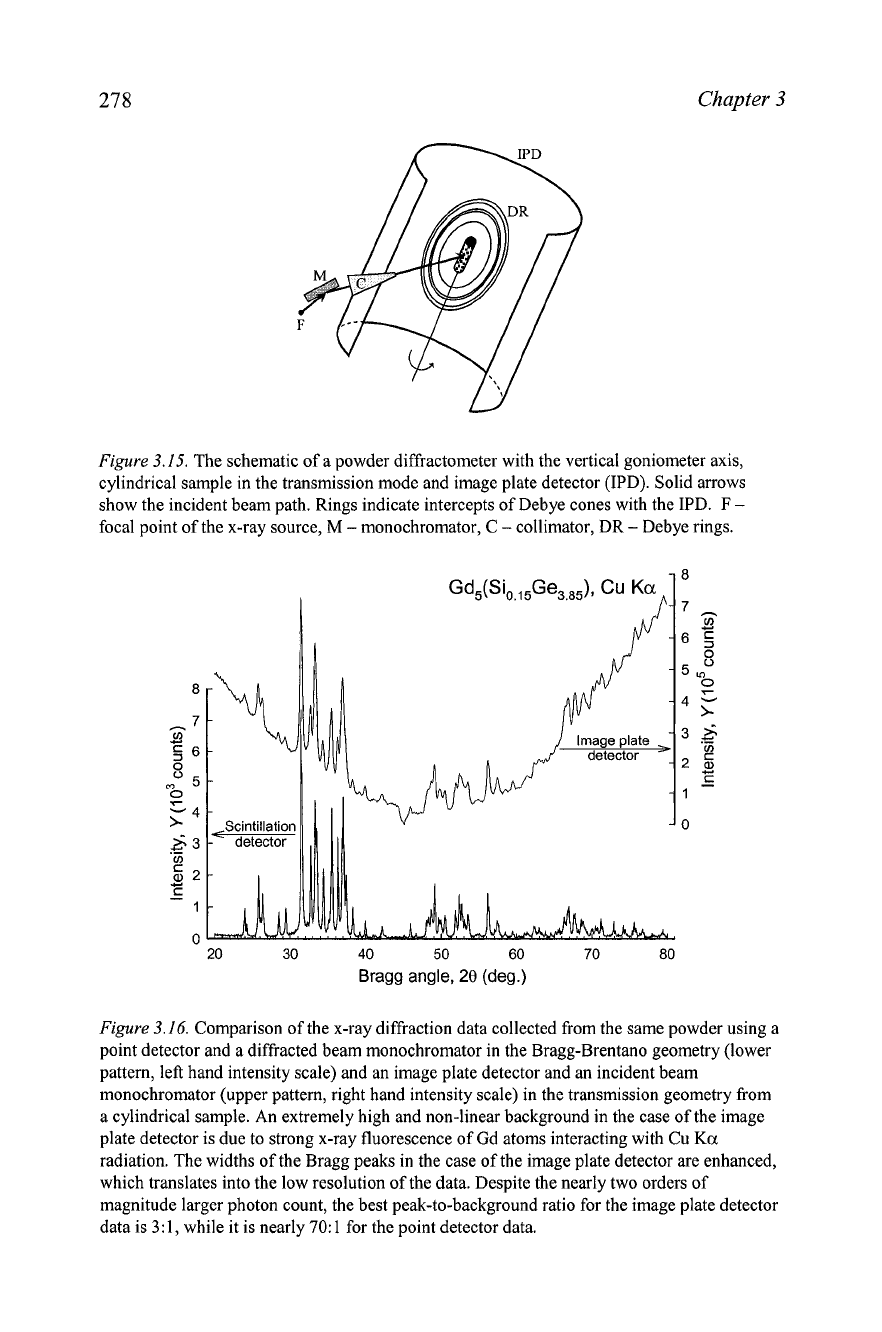
Chapter
3
Figure
3.15.
The schematic of a powder diffractometer with the vertical goniometer axis,
cylindrical sample in the transmission mode and image plate detector (IPD). Solid arrows
show the incident beam path. Rings indicate intercepts of
Debye cones with the IPD.
F
-
focal point of the x-ray source,
M
-
monochromator, C
-
collimator, DR
-
Debye rings.
Scintillatior
detector
20 30 40
50
60 70
80
Bragg angle,
20
(deg.)
Figure
3.16.
Comparison of the x-ray diffraction data collected from the same powder using a
point detector and a diffracted beam monochromator in the Bragg-Brentano geometry (lower
pattern,
left hand intensity scale) and an image plate detector and an incident beam
monochromator (upper pattern, right hand intensity scale) in the transmission geometry from
a cylindrical sample. An extremely high and non-linear background in the case of the image
plate detector is due to strong x-ray fluorescence of Gd atoms interacting with Cu
Ka
radiation. The widths of the Bragg peaks in the case of the image plate detector are enhanced,
which translates into the low resolution of the data. Despite the nearly two orders of
magnitude larger photon count, the best peak-to-background ratio for the image plate detector
data is
3:
1,
while it is nearly
70:
1
for the point detector data.
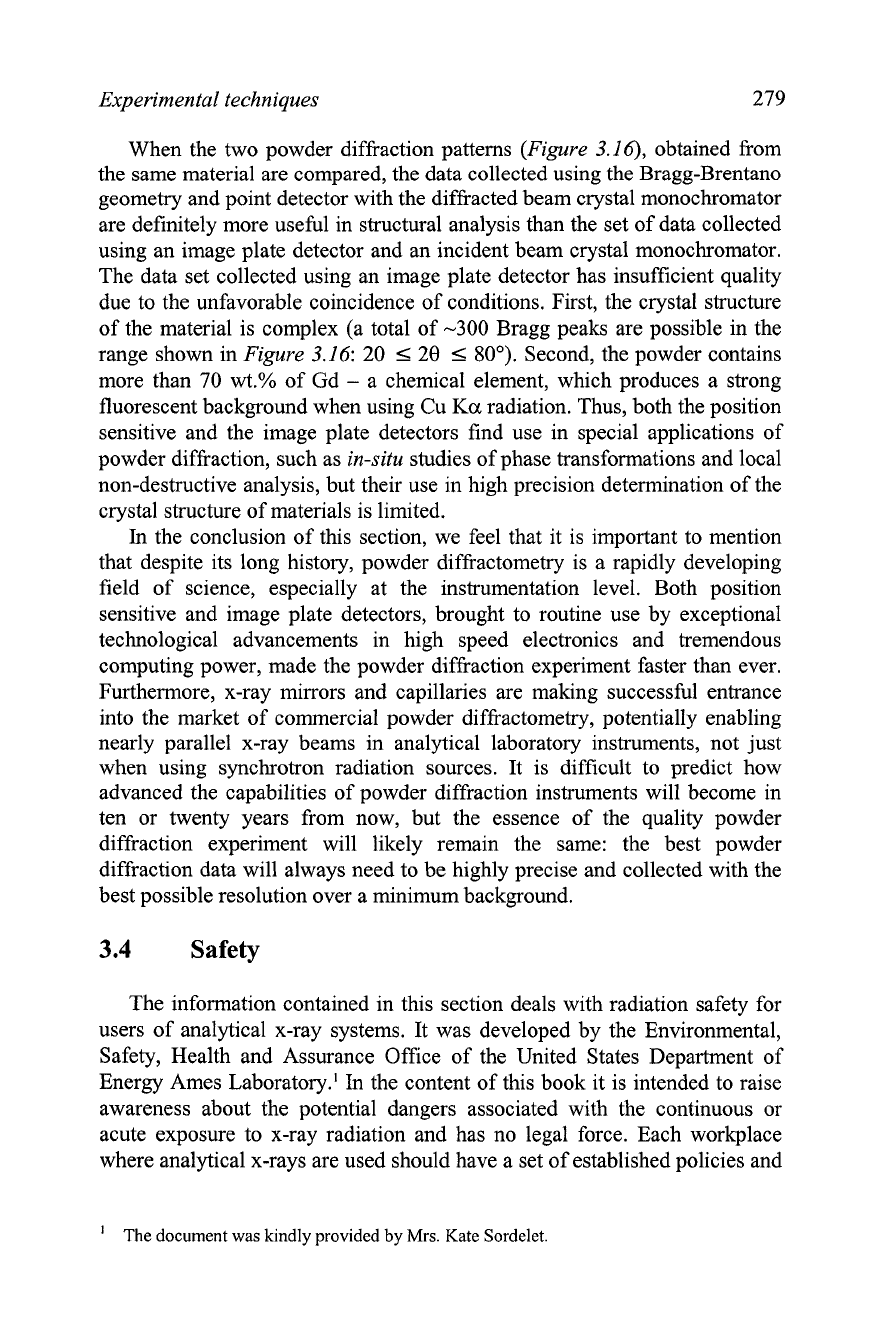
Experimental techniques 279
When the two powder diffraction patterns (Figure 3.16), obtained from
the same material are compared, the data collected using the Bragg-Brentano
geometry and point detector with the diffracted beam crystal monochromator
are definitely more useful in structural analysis than the set of data collected
using an image plate detector and an incident beam crystal monochromator.
The data set collected using an image plate detector has insufficient quality
due to the unfavorable coincidence of conditions. First, the crystal structure
of the material is complex (a total of -300 Bragg peaks are possible in the
range shown in Figure 3.16: 20
I
28
I
80"). Second, the powder contains
more than
70
wt.%
of Gd
-
a chemical element, which produces a strong
fluorescent background when using Cu
Ka
radiation. Thus, both the position
sensitive and the image plate detectors find use in special applications of
powder diffraction, such as in-situ studies of phase transformations and local
non-destructive analysis, but their use in high precision determination of the
crystal structure of materials is limited.
In
the conclusion of this section, we feel that it is important to mention
that despite its long history, powder diffractometry is a rapidly developing
field of science, especially at the instrumentation level. Both position
sensitive and image plate detectors, brought to routine use by exceptional
technological advancements in high speed electronics and tremendous
computing power, made the powder diffraction experiment faster than ever.
Furthermore, x-ray mirrors and capillaries are making successful entrance
into the market of commercial powder diffractometry, potentially enabling
nearly parallel x-ray beams in analytical laboratory instruments, not just
when using synchrotron radiation sources. It is difficult to predict how
advanced the capabilities of powder diffraction instruments will become in
ten or twenty years from now, but the essence of the quality powder
diffraction experiment will likely remain the same: the best powder
diffraction data will always need to be highly precise and collected with the
best possible resolution over a minimum background.
3.4
Safety
The information contained in this section deals with radiation safety for
users of analytical x-ray systems. It was developed by the Environmental,
Safety, Health and Assurance Office of the United States Department of
Energy Ames Laboratory.'
In
the content of this book it is intended to raise
awareness about the potential dangers associated with the continuous or
acute exposure to x-ray radiation and has no legal force. Each workplace
where analytical x-rays are used should have a set of established policies and
'
The document was kindly provided by
Mrs.
Kate Sordelet.
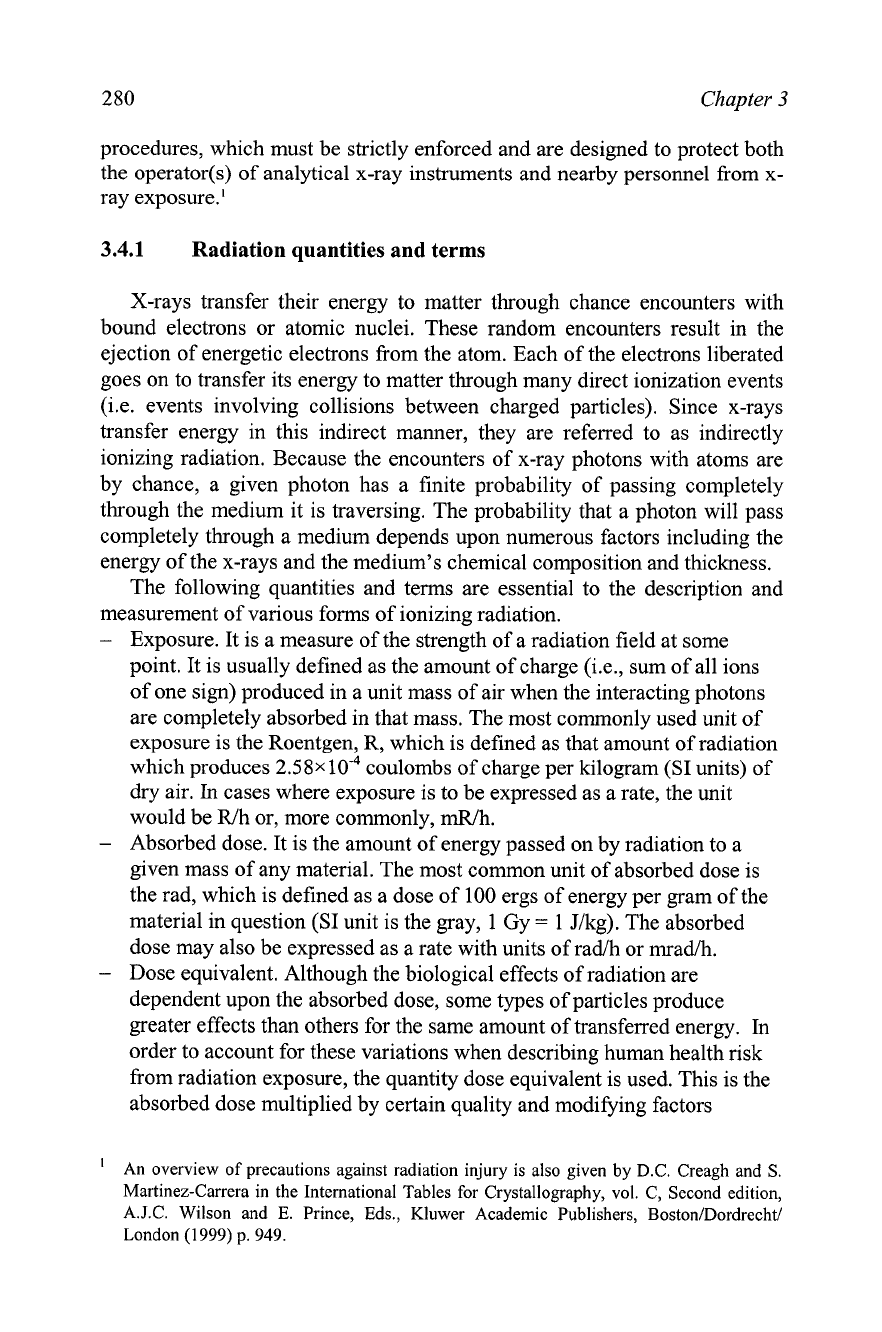
280
Chapter
3
procedures, which must be strictly enforced and are designed to protect both
the operator(s) of analytical x-ray instruments and nearby personnel from x-
ray exposure.'
3.4.1
Radiation quantities and terms
X-rays transfer their energy to matter through chance encounters with
bound electrons or atomic nuclei. These random encounters result in the
ejection of energetic electrons from the atom. Each of the electrons liberated
goes on to transfer its energy to matter through many direct ionization events
(i.e. events involving collisions between charged particles). Since x-rays
transfer energy in this indirect manner, they are referred to as indirectly
ionizing radiation. Because the encounters of x-ray photons with atoms are
by chance, a given photon has a finite probability of passing completely
through the medium it is traversing. The probability that a photon will pass
completely through a medium depends upon numerous factors including the
energy of the x-rays and the medium's chemical composition and thickness.
The following quantities and terms are essential to the description and
measurement of various forms of ionizing radiation.
-
Exposure. It is a measure of the strength of a radiation field at some
point. It is usually defined as the amount of charge (i.e., sum of all ions
of one sign) produced in a unit mass of air when the interacting photons
are completely absorbed in that mass. The most commonly used unit of
exposure is the Roentgen, R, which is defined as that amount of radiation
which produces
2.58~10-~
coulombs of charge per kilogram (SI units) of
dry air.
In
cases where exposure is to be expressed as a rate, the unit
would be
R/h
or, more commonly,
mR/h.
-
Absorbed dose. It is the amount of energy passed on by radiation to a
given mass of any material. The most common unit of absorbed dose is
the rad, which is defined as a dose of
100
ergs of energy per gram of the
material in question (SI unit is the gray,
1
Gy
=
1 Jlkg). The absorbed
dose may also be expressed as a rate with units of radlh or mradlh.
-
Dose equivalent. Although the biological effects of radiation are
dependent upon the absorbed dose, some types of particles produce
greater effects than others for the same amount of transferred energy. In
order to account for these variations when describing human health risk
from radiation exposure, the quantity dose equivalent is used. This is the
absorbed dose multiplied by certain quality and modifying factors
'
An overview of precautions against radiation injury is also given by D.C. Creagh and S.
Martinez-Carrera in the International Tables for Crystallography, vol. C, Second edition,
A.J.C. Wilson and E. Prince, Eds., Kluwer Academic Publishers,
Boston/Dordrecht/
London
(1
999)
p.
949.
